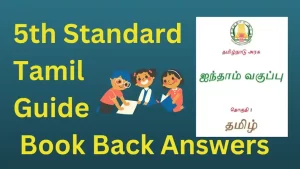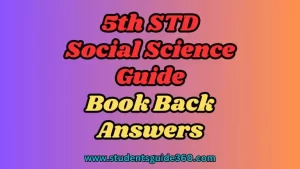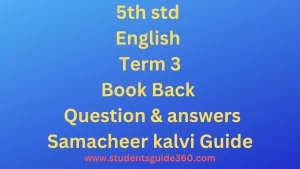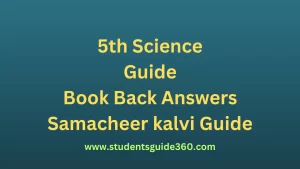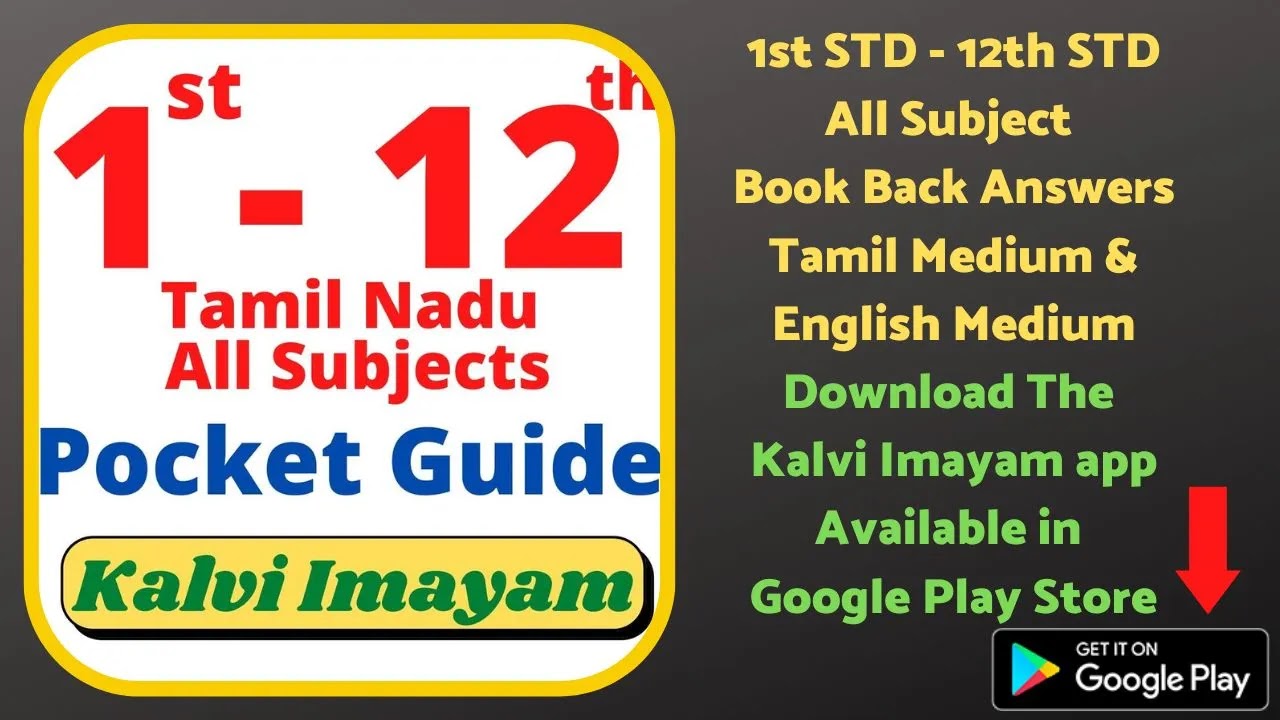5th Science Guide Term 1 Lesson 1 Organ System
TN 5th Science Solutions Term 1 Chapter 1 Organ System Book Back Answers
5th Science English Medium Guide. 5th Science Term 1 Lesson 1 Organ System Book Back and Additional Questions and Answers. TN Samacheer kalvi guide Science Solutions. 5th All Subject Text Books Download pdf. Class 5 / Fifth Standard Term 1 Lesson 1 Organ System question answers. Class 1 to 12 Book Back Guide.
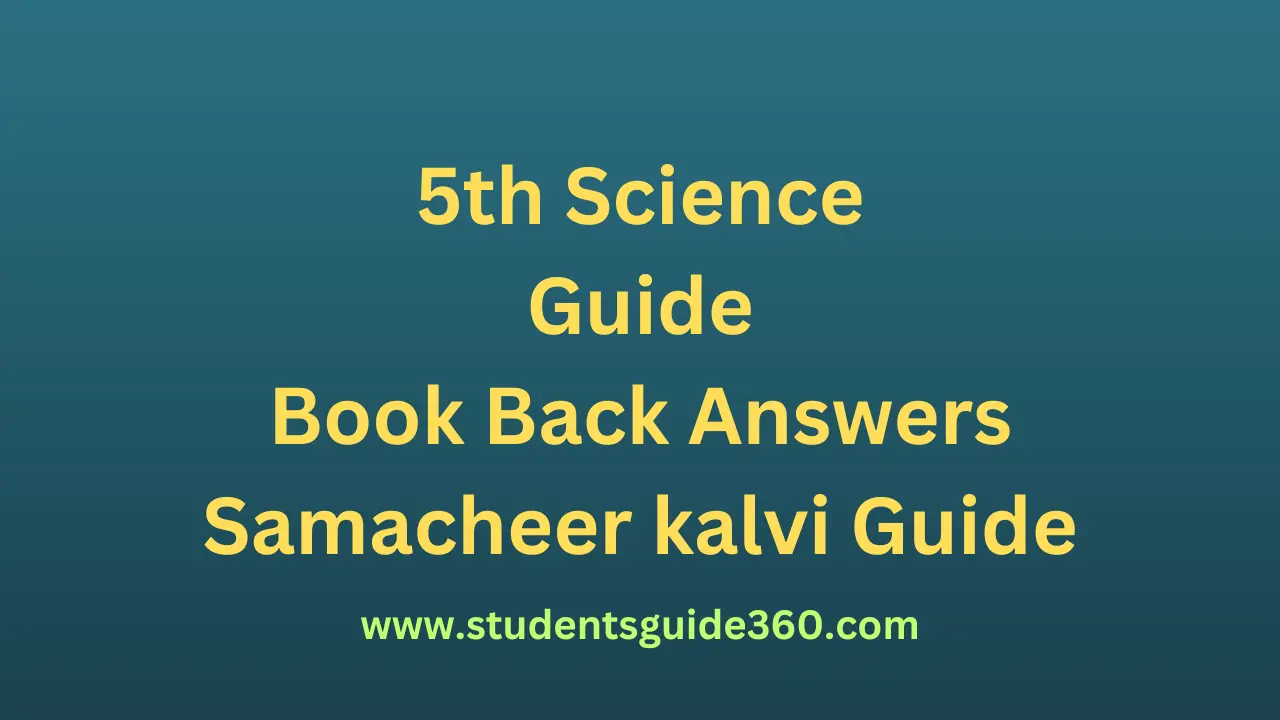
-
5th Std SCIENCE Term 1, 2, 3 All Unit Book Back & Addition Question and Answers – Tamil Medium & English Medium
-
5th All Subject Guide – Tamil Medium & English Medium
5th Science Guide Term 1 Lesson 1 Organ System
I. Choose the Correct Answer:
1. What is the length of the alimentary canal?
- a) 3-5 m
- b) 5-6 m
- c) 9-11 m
- d) 6-9 m
Answer:d) 6-9 m
2. Which organ is involved in respiration?
- a) Kidney
- b) Lungs
- c) Heart
- d) Brain
Answer:b) Lungs
3. How many kidneys do we have?
- a) 2
- b) 3
- c) 1
- d) 4
Answer:a) 2
4. Functional unit of brain is
- a) Neuron
- b) Nephron
- c) Brain stem
- d) Nerves
Answer:a) Neuron
5. Blood is bumped by
- a) Lungs
- b) Heart
- c) Kidneys
- d) Bones
Answer:b) Heart
II. Fill in the blanks:
1. A group of organs together make up an _______ system.
Answer:organ system
2. The process by which the body removes waste is called _______.
Answer:Excretion
3. The number of chambers in human heart is _______.
Answer:Four
4. The functional unit of kidney is _______.
Answer:Nephron
5. The human nervous system is divided into _______ parts.
Answer:Two
III. Say True or False:
1. The circulatory system is made up of the heart, blood, and blood vessels.
Answer: True
2. Important function of the heart is to transport blood with nutrients, oxygen, waste, and hormones.
Answer: True
3. The brain is protected by the rib cage.
Answer: False
4. The functional unit of kidney is neuron.
Answer: False
IV. Circle the odd one:
Question 1:

Answer:

V. Match the following:

Answer:
- C
- e
- d
- a
- b
VI. Answer briefly:
1. Name the salivary glands in our mouth?
Answer:
- The three parts of salivary glands in our mouth are parotid, sublingual and submandibular glands.
2. What is respiration?
Answer:
- The process of providing oxygen to the tissues of the body and removing carbon dioxide from the tissues is called respiration.
3. What is the function of pericardial fluid?
Answer:
- The space between the membranes is filled with pericardial fluid. This fluid protects the heart from shock.
4. Name the chambers in human heart?
Answer:
- The heart is divided into four chambers. Two upper chambers are called atria or auricles. Two lower thicker chambers are called ventricles. The upper and lower chambers are separated by a muscular wall or tissue known as auriculo-ventricular septum of the heart.
5. Arrange the excretory system in correct sequence.
(Urinary bladder, Ureter, Kidney, Urethra).
Answer:
- Kidney, Ureter, Urinary bladder, Urethra.
6.What are the two parts of peripheral nervous system?
Answer:
- Peripheral nervous system consists of nerves extending from spinal cord to all parts of the body. It is made up of 2 parts.
- Somatic nervous system
- Autonomous nervous system.
7. What are the functions of blood?
Answer:
- Blood transports nutrients, oxygen, wastes, and hormones.
- It regulates the water level and body temperature.
- It takes oxygen to tissues and cells finally reaches the lungs to take oxygen again.
VII. Answer in detail:
1. List out the functions of the digestive system.
Answer:
- The process of conversion of complex food molecules into simpler molecules is called digestion.
- Saliva moistens food.
- Salivary enzymes which break down complex starch into simple carbohydrate molecules.
- Digestive enzymes are used for digesting fats, proteins, and carbohydrates.
2. Explain the main parts of the circulatory system.
Answer:
- In circulatory system, Blood is circulated to transport oxygen and nutrients to every part of the body through circulatory system.
- Circulatory system consists of the
- Heart
- Blood
- Blood Vessels
- Heart:
- The heart is a hollow, muscular organ conical in shape.
- It is covered by a double walled pericardium membrane, filled with pericardial fluid.
- This fluid protects the heart from shock.
- Heart is placed inside the rib cage between the two lungs.
- Heart has 4 chambers, the two upper chambers called auricles.
- The two lower thicker chambers called ventricles.
- The upper and lower chambers of the heart are separated by muscular wall known as auriculo-ventricular septum.
- The right side of the heart receives de-oxygenated blood from various parts of body and pumped to the lungs for oxygenation.
- The left side of the heart receives oxygenated blood from the lungs and pumps to different parts of the body.
- Blood:
- It transports nutrients’ oxygen, wastes and hormones.
- It regulates the water level and body temperature.
- Blood pumped through out the body by the heart.
- It takes oxygen to the tissues and cells from the lungs.
- Blood vessels:
Blood vessels consists of arteries and veins. Arteries carry oxygenated blood except pulmonary arteries which carries deoxygenated blood from the heart vein carries deoxygenated blood except pulmonary veins which carries oxygenated blood to heart.
3. Explain three major parts of human brain.
Answer:
Human brain is divided into 3 major parts.
- Fore Brain (Cerebrum)
- Mid Brain (Cerebellum)
- Hind Brain (Medulla Oblongata)
- Fore Brain – Cerebrum
The fore brain consists of cerebrum, thalamus and hypothalamus.
- It is the largest part of the brain.
- It is the centre of human memory.
- It is responsible for intelligence, imagination and reasoning.
- Mid Brain – Cerebellum
- It lies behind the cerebrum.
- It co-ordinates the movements of the muscules of body.
- It helps to maintain the balance of the body.
- Hind Brain – Medulla Oblongata
- The hind brain comprises of pons and medulla oblongata.
- It is also called the brain stem.
- It controls breathing, heartbeat, and other involuntary muscles, so it is called “Vital Knot”.
- It connects the brain to the spinal cord.
4. Label the diagram given below.

Answer:
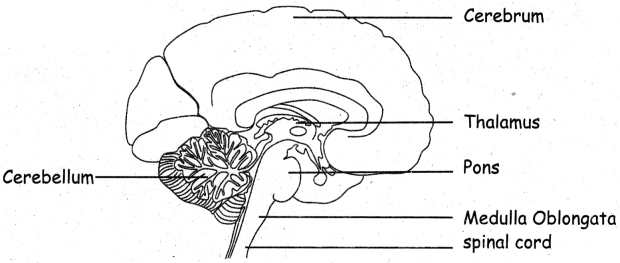
VIII. Questions based on higher order thinking (HOT):
1. Why It is important to wear helmet while riding a bike?
Answer:
Wearing helmet helps to protect your life and protect your head from danger. The head and brain is the most vulnerable to injury in a motorcycle accident. Drivers and passengers wearing helmets increase their chances of survival over non-helmet wearers. Riders who do not wear helmets are at risk of suffering a traumatic brain injury, if they are in accident. Brain trauma often results in spinal cord injuries and disability that requires extended care and physical therapy. The damaged brain may deteriorate after hospitalization and die days to weeks after the injury due to secondary injury.
2. Eating fast-food and junk food affects our health. Justify.
Answer:
- Fast food is usually higher in fat, calories cholesterol, and sodium in comparison to homemade meals.
- Eating too much fast food can increase the risk for health problems such as high blood pressure, heart disease, and obesity.
- Eating a poor quality diet high in junk food is linked to a higher risk of obesity, depression, digestive issues, heart diseases and stroke, type 2 diabetes, cancer, and early death.
5th Science Guide Organ System Additional Questions and Answers
I. Choose the Correct Answer:
Question 1.
The brain is kept in a bony case called
- a) Cranium
- b) Cerebellum
- c) Cerebrum
- d) Medulla Oblongata
Answer:a) Cranium
Question 2.
The left side of the heart receives oxygenated blood from
- a) Lung
- b) Heart
- c) Liver
- d) Kidney
Answer:a) Lung
Question 3.
Name the functional unit of brain
- a) Neurons
- b) Nephrons
- c) Fibrous membrane
- d) Capsule
Answer:a) Hind Brain
Question 4.
The brain loses the ability to function when it does not get oxygen for more than.
- a) 2 minutes
- b) 3 minutes
- c) 4 minutes
- d) 5 minutes
Answer:4 minutes
Question 5.
The volume of blood in human adults is _______.
- a) 4-5 litres
- b) 5-6 litres
- c) 3-5 litres
- d) 4-8 litres
Answer:a) 4-5 litres
Question 6.
The volume of blood in human adults is _______.
- a) 4-5 litres
- b) 5-6 litres
- c) 3-5 litres
- d) 4-8 litres
Answer:a) 4-5 litres
Question 7.
Heart ¡s covered with double walled membrane called
- a) cerebrum
- b) Cerebellum
- c) pericardium
- d) rib cage
Answer:c) pericardium
Question 8.
____________ carries sensation’s from the organs to the brain.
- a) Somatic nervous system
- b) Autonomous nervous system
- c) Central nervous system
- d) Spinal cord
Answer:Somatic nervous system
Question 9.
____________ is the largest part of the brain.
- a) Fore Brain
- b) Mid Brain
- c) Hind Brain
- d) Centre Brain
Answer:a) Fore Brain
Question 10.
Medulla oblongata is called as
- a) pia meter
- b) durameter
- c) vital knot
- d) pons verolli
Answer:c) vital knot
Question 11.
Which of the following statement is correct about cerebellum?
- a) It is the largest part of the brain
- b) It co-ordinates the movements of the muscles of the body.
- c) It controls involuntary action
- d) It lies behind the cerebrum
Answer:Both (b) and (d)
II. Fill in the blanks:
Question 1.
Salivary glands secrete _______.
Answer:saliva
Question 2.
Name the organism which lives in the digestive system of human _______.
Answer:Tapeworm
Question 3.
Liver produces for the digestion of fat.
Answer:Bile
Question 4.
________ is sac – like in shape.
Answer:Urinary bladder
Question 5.
Kidneys receive approximately ________ litres of blood.
Answer:250 liter
Question 6.
The kidneys are made up of millions of excretory units called _______.
Answer:Nephrons
III. Say True or False:
Question 1.
Liver transport nutrients, oxygen, wastes, and hormones.
Answer:False
Question 2.
Blood vessels consist of arteries and veins.
Answer:True
Question 3.
Crab has blue blood.
Answer:True
Question 4.
Autonomous nervous system carries sensation from the organs_______ to the brain.
Answer:True
Question 5.
Average weight of human brain ¡s 2.3 kg.
Answer:False
Question 6.
Brain is made up of eight immovable bones.
Answer:True
Question 7.
Fore brain lies behind the cerebrum.
Answer:False
Question 8.
Fore brain is the centre of human memory.
Answer:True
5th Science Guide Term 1 Lesson 1 Organ System
IV. Circle the odd one out:
Question 1.
(a) Heart
(b) Blood vessels
(c) Airway
(d) Pancreatic juice
Answer:(d) Pancreatic juice
Question 2.
(a) Air way
(b) Lungs
(c) Liver
(d) Muscles of respiration
Answer:(c) Liver
Question 3.
(a) pancreatic juice
(b) Bile
(c) Digestive enzymes
(d) paracardial fluid
Answer:(d) paracardial fluid
Question 4.
(a) Nasal cavity
(b) Pharynx
(c) Nostrils
(d) Pancreas
Answer:(d) Pancreas
Question 5.
(a) Dura mater
(b) Cranium
(c) Arachnoid membrane
(d) Pia meter
Answer:(b) Cranium
Question 6.
(a) Pharynx
(b) Larynx
(c) bronchi
(d) Arteries
Answer:(d) Arteries
V. Match the following:
Question 1.

Answer:
- d
- a
- b
- c
Question 2.

Answer:
- b
- a
- d
- c
VI. Answer briefly:
Question 1.
What is digestion?
Answer:
- The process of conversion of complex food molecules into simpler molecules is called digestion.
Question 2.
What are the compounds present in the food?
Answer:
- The food contain complex compounds like carbohydrates, proteins and fats.
Question 3.
Mention the 3 important digestive glands in the process of digestion?
Answer:
- Three important digestive glands in the process of digestion are:
- Salivary glands
- Pancreas
Question 4.
Why do we eat?
Answer:
- Food contains sources of energy that the body needs to stay alive and to repair itself.
Question 5.
What happens when we swallow our food?
Answer:
- Our tongue squeezes off a portion and pushes down into your throat to the top of the esophagus.
- When we swallow muscular waves push the food along the digestive tract from the mouth down the esophagus to the stomach.
- From the stomach, it moves on to the small and large intestine.
Question 6.
What are the most important toxic gases in smoke?
Answer:
- Smoke contains many toxic gases. The most common is carbon monoxide.
Question 7.
What is the primary organ of the respiratory system?
Answer:
- The lungs are the primary organs of the respiratory system. They are paired cone-shaped organs. They are located near the backbone on both sides of the heart.
Question 8.
Name the muscles of respiration?
Answer:
- Muscles of respiration include diaphram and intercostal muscles.
VII. Answer in detail:
Question 1.
Draw a flow chart to explain the function of digestive system in human being.
Answer:
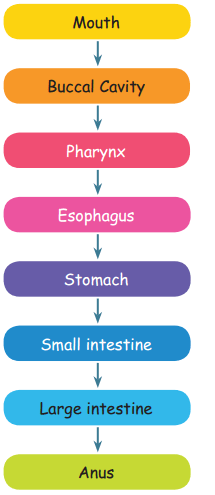
2. Draw and label the parts for the structure of kidney.
Answer:
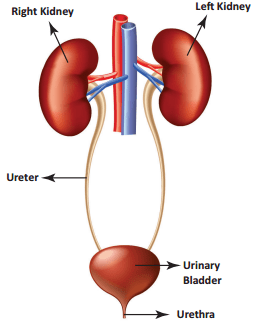 The heart ¡s a hollow, muscular organ. It ¡s conical ¡n shape.
The heart ¡s a hollow, muscular organ. It ¡s conical ¡n shape.- It ¡s covered with double walled membrane called pericardiurn.
- The space between themembranes is filled with pericardial fluid. .
- The pericardial fluid protects the heart from shock.
- Heart ¡s placed inside the thoracic chamber (rib cage) ¡n between the two lungs.
- The heart ¡s divided into four chambers.
- Two upper chambers are called atrio or auricles.
- Two lower thicker chambers are called ventricles.
- The upper and lower chambers of the heart are separated by a muscular wall or tissue known as the auriculo-ventricular septum of the heart.
- The right side of the heart receives deoxygenated blood from various parts of the body and pumps it to the lungs for oxygenation.
- The left side of the heart receives oxygenated blood from the lungs and pumps it into different parts of the body.

